-
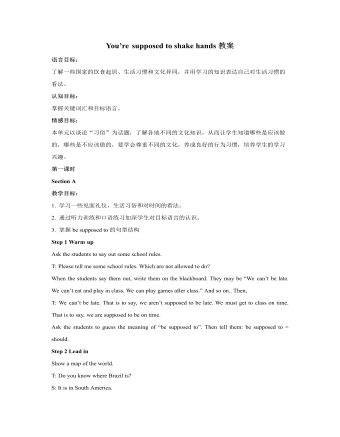
人教版新目标初中英语九年级下册You’re supposed to shake hands教案
教学目标:1. 掌握本单元一些重点词汇的写法和用法。2. 学会自如谈论餐桌礼仪。Step 1 RevisionAsk some students to retell the customs at the table in France in the passage in 3a.Step 2 Self checkPart 1. Fill in each bland with the correct word given. Students do the exercises by themselves at first. Then check the answers. Ask the students to comprehend the sentences and help them point out uses of some words, like “arrive (at / in) sw., spend time / money on sth , spend time / money (in) doing sth.”Part 2. Read about Fan Ling’s experience in a western restaurant. Understand the passage. Point out some key points in the passage.1. be / get used to doing sth. 习惯做某事2. begin with = start with 以….开头3. crowd v. 挤满,塞满 the crowd 人群 crowded adj. 拥挤的Then students discuss about how she would solve her problem. Ask some to share their stories with others.Part 3. Complete the crossword by looking at the sentences on the left. Then check the answers.
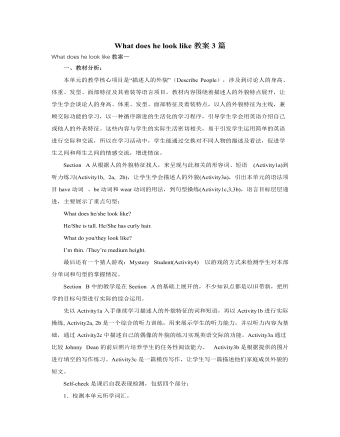
人教版新目标初中英语七年级下册What does he look like教案3篇
所需要用到的句子:Who is that?That is Jack. I like him.Why do you like him?I like him because he is interesting.Task 4: 设计理想中的人类Step one: 设计理想中的人类的外貌。把全班同学分成若干小组,学生可以边说边在纸上画出他们的模样。Step two: 设计理想中人类的性格。学生们可以把那些能描述性格的单词写在图画的旁边。Step three: 每组选出一名同学,其他同组同学提问,他作简单回答,并说明原因。所需用到的句子:What does he or she look like?He or she ...What is he or she like?He or she is ...Why?Because ...Task 5: 挑战性活动调查性格是天生的还是后天形成的,让每个同学回家去调查一下自己成长过程中性格是否有变化,具体是怎样的,为什么会这样? Teaching Aims:1. Enable students to have a general understanding of how to talk about people's physical appearance.2. Enable students to tackle some essential vocabularies and patterns about describing people. Provide them with necessary skills and methods.3. Create various chances for students to describe the persons they're familiar with, such as classmates, family members, teachers, idols, etc.
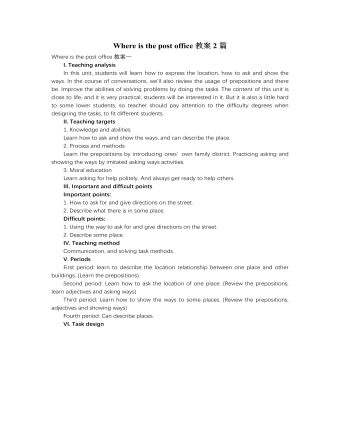
人教版新目标初中英语七年级下册Where is the post office教案2篇
Period 2 (3a----Section B 2c)Preview(Pre-task): Key points: What laAdd another information about their pen pals----their language on the cardnguage does she/he speak?She/He speaks....Does she/he have any brothers and sisters? Does she/he speak English?Preview(Pre-task): Add another information about their pen pals----their language on the cardKey points: What language does she/he speak?She/He speaks....Does she/he have any brothers and sisters? Does she/he speak English?Step 1 Revision1.Revisionand dictation of the new words 2.Revise the drills they learned yesterday.(by pairwork and grammar exercise)Step 2 Leading-inT has a conversation with one student. The conversation is following:---Do you have a pen pal?---Yes, I do.---What's your pen pal's name? ---His/Her name is....---Where is your pen pal from? ---He/She is from...---Where does he/she live? ---He/She lives in....---What language does he/she speak?He/She speaks...Write the new words on the Bb. They are following: EnglishChineseJapaneseFrenchStep 3 LearnLearn the new words with the whole class.Finish 3a with the students3b Pairwork T still does an example with one student Then the Ss practise in pairs. The example is following:--Curry Muray is my pen pal. He is from the United States.---What language does he speak?
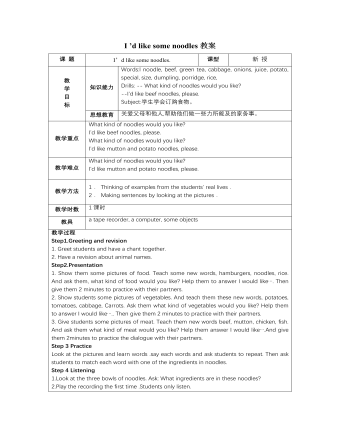
人教版新目标初中英语七年级下册I ’d like some noodles教案
教学过程Step 1: warming-up Sing a song---------“food and drink” Step 2: Revision1 Dictation2 Revise: What kind of noodles would you like?I’d like …What size bowl of noodles would you like?I’d like…Step 3: Presentation1 show pictures of food, ask students say the words.2 Students read the newspaper ad in 3a. Fill in blanks with words in the box. Then read the ad together, the teacher explains some difficult language points.3 Check the answers Step 4 PracticeAsk students to finish 3b in the same way according to 3a. Students read the short passage and fill in the blanks .At last, check the answers.Step 5 productionAsk students to write their own ad for dumplings, noodles, drinks, and other foods they know. Then ask students to read their partner’s ad. Then order food and drink from their partner.Step 6 Home workGroup work – make an ad about “food and drink”

人教版新目标初中英语七年级下册Where is your pen pal from教案
2.1Match the country with the language.Step II Reading3a? let the students read the letter fast and answer the questions.? Let the students ask more questions about the letter as possible as the can.Step III Writing3b.Step IV. Pairwork2cStep V Listening2a, 2bStep V. HomeworkExercises book(1) P3Exercises book (2) P3Period FourStep I . Dictate the words and sentences in Unit1.Step II. Self-checkStep III. Check the answers for Exercises book in the unit.Step IV. Home workRevise and preparation for unit 2.教学反思:通过本单元的学习,学生基本可以谈论人们的国籍,居住城市及其所说的语言,通过书信方式去介绍自己并寻找笔友。但在涉及到国外的一些城市时,学生对这方面的知识相对欠缺,能介绍的城市并不多,也反应出学生课前预习不充分,这跟学生学习条件也有关,大多数学生无法通过网络获取所需信息。因此,在以后的教学中要多指导学生通过计算机网络获取信息,拓宽知识面。
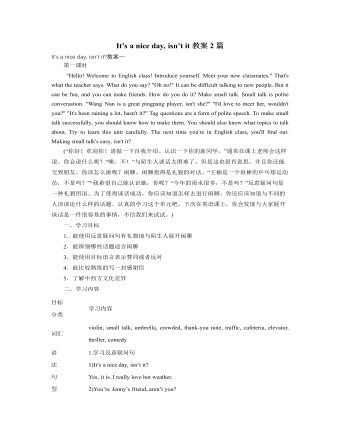
人教版新目标初中英语八年级下册It’s a nice day, isn’t it教案2篇
"Hello! Welcome to English class! Introduce yourself. Meet your new classmates." That's what the teacher says. What do you say? "Oh no!" It can be difficult talking to new people. But it can be fun, and you can make friends. How do you do it? Make small talk. Small talk is polite conversation. "Wang Nan is a great pingpang player, isn't she?" "I'd love to meet her, wouldn't you?" "It's been raining a lot, hasn't it?" Tag questions are a form of polite speech. To make small talk successfully, you should know how to make them. You should also know what topics to talk about. Try to learn this unit carefully. The next time you're in English class, you'll find out. Making small talk's easy, isn't it? (“你好!欢迎你!请做一下自我介绍。认识一下你的新同学。”通常在课上老师会这样说。你会说什么呢?“噢,不!”与陌生人谈话太困难了。但是这也很有意思,并且你还能交到朋友。你该怎么做呢?闲聊。闲聊指得是礼貌的对话。“王楠是一个很棒的乒乓球运动员,不是吗?”“我希望自己能认识她,你呢?“今年的雨水很多,不是吗?”反意疑问句是一种礼貌用语。为了使得谈话成功,你应该知道怎样去进行闲聊。你还应该知道与不同的人该谈论什么样的话题。认真的学习这个单元吧,下次在英语课上,你会发现与大家展开谈话是一件很容易的事情,不信我们来试试。)
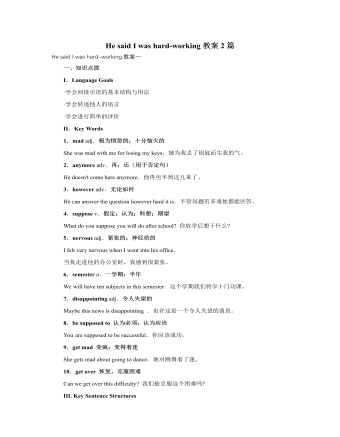
人教版新目标初中英语八年级下册He said I was hard-working教案2篇
This activity introduces some new vocabulary and provide oral practice using the target language.Task 1 . Ask four students to stand in front of the class, and the teacher asks them the following questions as a reporter.1.What are you going to do when you grow up?2.What are you going to do next week?3.What are going to do after school?The students will give different answers, then ask a good student to report what they said.I am going to e a doctor.What did she say?----------She said she was going to be a doctor.I am going to have a party on Friday night.What did he say?-------He said he was going to have a party on Friday night.I am going to do my homework.What did she say ?------ She said she was going to do her homework.I am going home after school.What did she say?-----She said she was going home after school.Say In this unit we are going to learn to use words like to report what someone said.Task 2. Read the instructions. Then ask a student to read the four questions. And write the words on the Bb. Explain what soap opera is.Task 3. Ask the students to Look at the pictures, point out the TV screens in the picture. Ask one girl to read what Marcia said.What did Marcia say? She said She said she was having a surprise party for Lana on Friday night. Repeat the other pictures in the same way.Activity3. Listen and number the pictures in activity 1a.
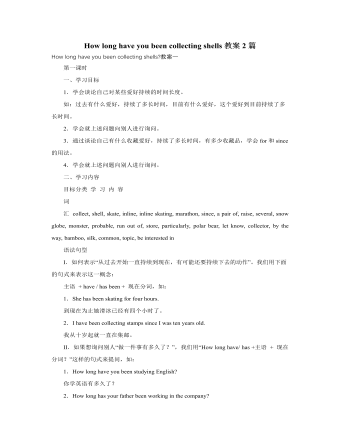
人教版新目标初中英语八年级下册How long have you been collecting shells教案2篇
Step Ⅱ Show the new words on the screen and teach the new words. Read the new words to students and ask them to repeat.Step Ⅲ 3aThis activity introduces new vocabulary and provides reading practice using the target language.In this activity first look at the four pictures.T: What can you see in the pictures?Ss: Four snow globes.T: Right. There are four snow globes in the pictures. And what are they?Ss: They are a monster, two polar bears, two penguins and a birthday cake.Write these words on the blackboard: snow globe; monster; polar bear; penguin and birthday cake. Read them to the class and ask students to repeat each one. Make sure students understand each word.Use a computer to show the E-mail message on the screen and read the message to students.Get students to read the e-mail on their own, and then draw lines connecting each snow globe and its description.Correct the answers.AnswersA line should connect each snow globe picture with the words that describe it in the letter.Step Ⅳ 3bThis activity provides writing practice using the target language.First review Activity 2a on Page 47.Then ask students to complete the message according to Activity 2a.Some partial sentences are given to students. Write about one person's collection.When students work, walk around the room checking the progress and offering help as needed.When they finish, ask some students to read their messages to the class.
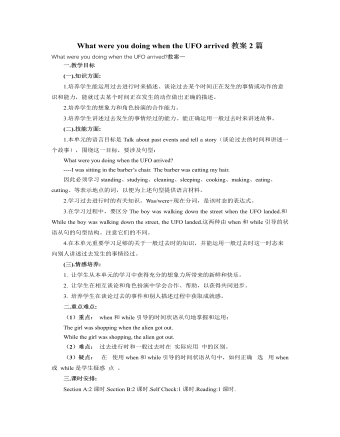
人教版新目标初中英语八年级下册What were you doing when the UFO arrived教案2篇
(一).知识方面: 1.培养学生能运用过去进行时来描述、谈论过去某个时间正在发生的事情或动作的意识和能力,能就过去某个时间正在发生的动作做出正确的描述。 2.培养学生的想象力和角色扮演的合作能力。 3.培养学生讲述过去发生的事情经过的能力。能正确运用一般过去时来讲述故事。 (二).技能方面: 1.本单元的语言目标是Talk about past events and tell a story(谈论过去的时间和讲述一个故事),围绕这一目标,要涉及句型: What were you doing when the UFO arrived? ----I was sitting in the barber’s chair. The barber was cutting my hair. 因此必须学习standing、studying、cleaning、sleeping、cooking、making、eating、cutting、等表示地点的词,以便为上述句型提供语言材料。2.学习过去进行时的有关知识。Was/were+现在分词,是该时态的表达式。 3.在学习过程中,要区分The boy was walking down the street when the UFO landed.和While the boy was walking down the street, the UFO landed.这两种由when和while引导的状语从句的句型结构。注意它们的不同。

人教版新目标初中英语八年级下册Why don’t you get her a scarf教案
教师带领学生复习有关描述宠物的词汇,采用教师提问学生回答的方进行。如:T:What animals do you think would be good pets?What animals do you think would be bad pets?What do you think are good animals for a six-year-old child?然后学生进行 pairwork 练习。Task two: 师生互动,学习探究 1、播放3a部分的录音,引导学生一边听录音,一边跟读。2、通过听录音学生回答以下问题:Why do you think pot-bellied pigs are popular?What are the advantages and disadvantages of keeping such a pet?教师对学生的回答进行及时点评。3.学习范文,学习重点短语,为下步的模仿写作提供语言素材。T :1. )Have you ever kept a pig as a pet?Do you like pigs? St.:No.…Why don’t you like to keep a pig? St: No.They’re too dirty and lazy(Do you know in some foreign countries like Hollyland, Australia,pigs are the most popular pet.there’s a kind of pig.(图)it has an interesting name? it ‘s called a pot-bellied pig.) Now,let’s learn an article about this kind of interesting pet.2.)play the tapeSt.:Listen and repeat3.)show some Qs on computer(本子St.: read silently,then answerthe Qs(本子)4.)Ask ss. Close book and retell this passage.(what is a pot-bellied pig? Is it a good or bad pet? ) St.: retell it to each other“A pot –bellied pig is a popular pet now…”5.read the article together.St.:.practice reading
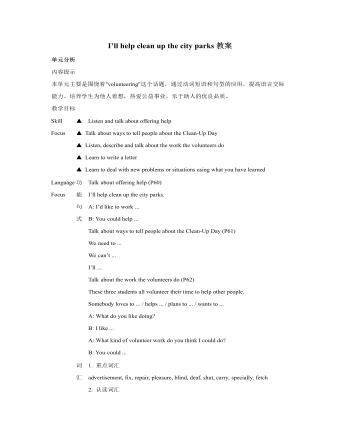
人教版新目标初中英语九年级下册I’ll help clean up the city parks教案
Talk about offering help (P60)I’ll help clean up the city parks.A: I’d like to work ...B: You could help ...Talk about ways to tell people about the Clean-Up Day (P61)We need to ...We can’t ...I’ll ...Talk about the work the volunteers do (P62)These three students all volunteer their time to help other people.Somebody loves to ... / helps ... / plans to ... / wants to ...A: What do you like doing?B: I like ... A: What kind of volunteer work do you think I could do?B: You could ...1. 重点词汇advertisement, fix, repair, pleasure, blind, deaf, shut, carry, specially, fetch2. 认读词汇hunger, homeless, cheer, clean-up, sign, establish, major, commitment, elementary, veterinarian, coach, similar, call-in, strategy, disabled, organization, unable, support, appreciate, donation, part of speech, pronoun, adverb, preposition, conjunction, donate, Jimmy, Sally3. 词组clean up, cheer up, give out, put off, set up, think up, take after, fix up, give away, put up, hand out, work out, at once

初中数学浙教版七年级下册《第二章 二元一次方程组 三元一次方程组及其解法》教材教案
知识与技能目标:1. 能正确说出三元一次方程(组)及其解的概念,能正确判别一组数是否是三元一次方程(组)的解;2. 会根据实际问题列出简单的三元一次方程或三元一次方程组。过程与方法目标:1. 通过加深对概念的理解,提高对“元”和“次”的认识。2. 能够逐步培养类比分析和归纳概括的能力,了解辩证统一的思想。情感态度与价值观目标:通过对实际问题的分析,使学生进一步体会方程是刻画现实世界的有效数学模型,培养学生良好的数学应用意识。
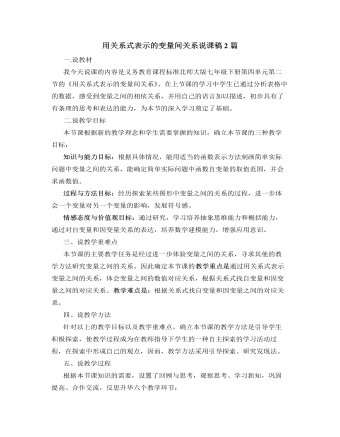
北师大版初中七年级数学下册用关系式表示的变量间关系说课稿2篇
一.说教材我今天说课的内容是义务教育课程标准北师大版七年级下册第四单元第二节的《用关系式表示的变量间关系》。在上节课的学习中学生已通过分析表格中的数据,感受到变量之间的相依关系,并用自己的语言加以描述,初步具有了有条理的思考和表达的能力,为本节的深入学习奠定了基础。二.说教学目标本节课根据新的教学理念和学生需要掌握的知识,确立本节课的三种教学目标:知识与能力目标:根据具体情况,能用适当的函数表示方法刻画简单实际问题中变量之间的关系,能确定简单实际问题中函数自变量的取值范围,并会求函数值。过程与方法目标:经历探索某些图形中变量之间的关系的过程,进一步体会一个变量对另一个变量的影响,发展符号感。情感态度与价值观目标:通过研究,学习培养抽象思维能力和概括能力,通过对自变量和因变量关系的表达,培养数学建模能力,增强应用意识。
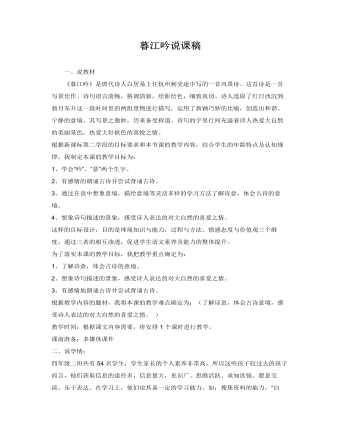
(新)部编人教版四年级上册《古诗三首》(一)说课稿(二)
一、说教材:对于《题西林壁》这篇课文,我是这样解读的:《题西林壁》是一首哲理诗,作者通过描写游览庐山的经历,总结出观察问题应客观全面,如果主观片面,就得不出正确的结论的道理。二、说学情:对于学生的情况,我是这样认为的:四年级的学生,他们的思维以具象思维为主,因此他们对于文中描写的景物有自己的感触。但是他们抽象思维能力较弱,而本诗又是一首哲理诗,学生在理解上有一定的难度,这就需要教师加以引导。除此之外,学生的有意注意力和稳定性还是较差的,所以教师在教学过程中要运用多媒体、图片等来增强教学的直观性、形象性,以吸引学生的注意力。
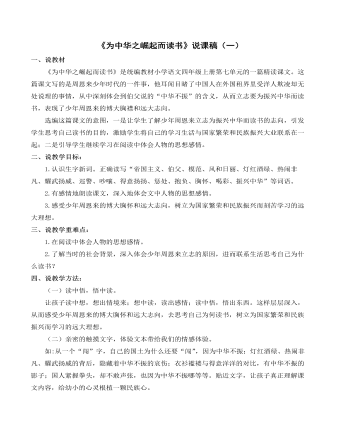
(新)部编人教版四年级上册《为中华之崛起而读书》说课稿(一)
1.初步探究,找切入点:我抛出问题:周恩来为什么会立下“为中华之崛起而读书”这一志向?文中的哪个词最能体现?这个词在文中出现几次?通过多个问题的设置,培养学生的理解能力,学生通过自己读课文,很快就能找出本文的关键词“中华不振”,在文中出现2次,进而引导学生划出句子。 2.比较阅读,交流发现:让生反复阅读两个句子,比较两处出现的“中华不振”有什么不同,然后在班上交流自己的发现,通过仔细比较阅读会发现:第一次的“中华不振”是由伯父告诉周恩来的,第二次的“中华不振”是由周恩来自己亲身体会到的。这一环节的设置,进一步激发学生的探索意识,让学生学会在阅读中进行比较分析,进一步的理解内容,体验情感。3.默读课文,交流感受:新课程标准指出:要让三四年级学生学会默读,做到不出声,不指读。通过让生默读课文,边读边感受:文中的哪些句子能让你感受到“中华不振”?划出相关句子,然后在班上交流感受,通过交流,有的同学会说:我从伯父的话语中能感受,有的会说:从妇女的哭诉中感受【这一环节的设置,通过让生读课文,找句子,谈感受,加深对“中华不振”的理解,更深入的体会当时周恩来的心情,理解周恩来立下志向的原因。
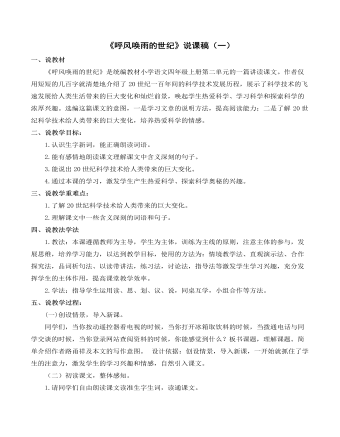
(新)部编人教版四年级上册《呼风唤雨的世纪》说课稿(一)
四、说教法学法 1.教法:本课遵循教师为主导,学生为主体,训练为主线的原则,注意主体的参与,发展思维,培养学习能力,以达到教学目标,使用的方法为:情境教学法、直观演示法、合作探究法,品词析句法、以读带讲法,练习法,讨论法,指导法等激发学生学习兴趣,充分发挥学生的主体作用,提高课堂教学效率。 2.学法:指导学生运用读、思、划、议、说,同桌互学,小组合作等方法。五、说教学过程:(一)创设情景,导入新课。 同学们,当你按动遥控器看电视的时候,当你打开冰箱取饮料的时候,当拨通电话与同学交谈的时候,当你登录网站查阅资料的时候,你能感觉到什么?板书课题,理解课题。简单介绍作者路甬祥及本文的写作意图。 设计依据:创设情景,导入新课,一开始就抓住了学生的注意力,激发学生的学习兴趣和情感,自然引入课文。
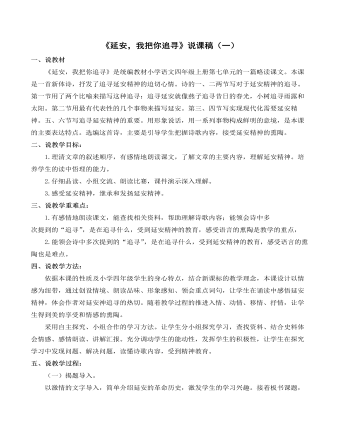
(新)部编人教版四年级上册《延安,我把你追寻》说课稿(一)
四、说教学方法: 依据本课的性质及小学四年级学生的身心特点,结合新课标的教学理念,本课设计以情感为纽带,通过创设情境、朗读品味、形象感知、领会重点词句,让学生在诵读中感悟延安精神,体会作者对延安神追寻的热切。随着教学过程的推进入情、动情、移情、抒情,让学生得到美的享受和情感的熏陶。 采用自主探究、小组合作的学习方法。让学生分小组探究学习,查找资料、结合史料体会情感、感情朗读、讲解汇报。充分调动学生的能动性,发挥学生的积极性,让学生在探究学习中发现问题、解决问题,读懂诗歌内容,受到精神教育。五、说教学过程:(一)揭题导入。 以激情的文字导入,简单介绍延安的革命历史,激发学生的学习兴趣。接着板书课题,让学生读题质疑。以三个问题:为什么追寻?追寻什么?怎样追寻?提挈全文,初步建立诗歌的层次。 学生交流对延安的了解,补充简介延安,让学生加深对延安革命圣地的感受。
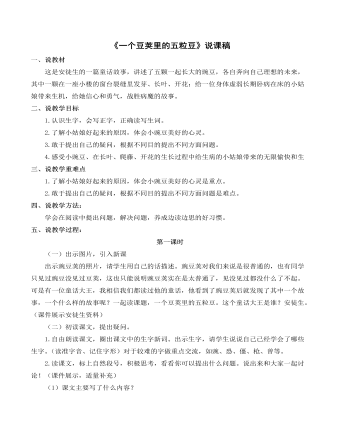
(新)部编人教版四年级上册《一个豆荚里的五粒豆》说课稿
一、说教材 这是安徒生的一篇童话故事,讲述了五颗一起长大的豌豆,各自奔向自己理想的未来,其中一颗在一座小楼的窗台裂缝里发芽、长叶、开花;给一位身体虚弱长期卧病在床的小姑娘带来生机,给她信心和勇气,战胜病魔的故事。二、说教学目标 1.认识生字,会写正字,正确读写生词。 2.了解小姑娘好起来的原因,体会小豌豆美好的心灵。3.敢于提出自己的疑问,根据不同目的提出不同方面问题。 4.感受小豌豆、在长叶、爬藤、开花的生长过程中给生病的小姑娘带来的无限愉快和生三、说教学重难点1.了解小姑娘好起来的原因,体会小豌豆美好的心灵是重点。2.敢于提出自己的疑问,根据不同目的提出不同方面问题是难点。四、说教学方法: 学会在阅读中提出问题,解决问题,养成边读边思的好习惯。
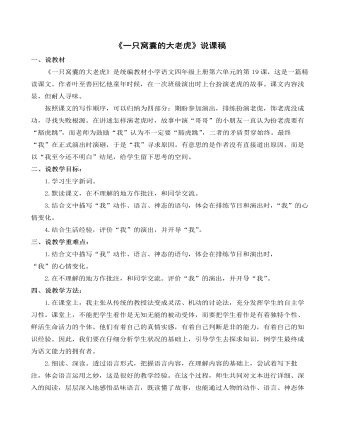
(新)部编人教版四年级上册《一只窝囊的大老虎》说课稿
一、说教材 《一只窝囊的大老虎》是统编教材小学语文四年级上册第六单元的第19课,这是一篇精读课文。作者叶至善回忆他童年时候,在一次班级演出时上台扮演老虎的故事。课文内容浅显,但耐人寻味。按照课文的写作顺序,可以归纳为四部分:期盼参加演出,排练扮演老虎,饰老虎没成功,寻找失败根源。在讲述怎样演老虎时,故事中演“哥哥”的小朋友一直认为扮老虎要有“豁虎跳”,而老师为鼓励“我”认为不一定要“豁虎跳”,二者的矛盾贯穿始终。最终“我”在正式演出时演砸,于是“我”寻求原因。有意思的是作者没有直接道出原因,而是以“我至今还不明白”结尾,给学生留下思考的空间。二、说教学目标: 1.学习生字新词。2.默读课文,在不理解的地方作批注,和同学交流。
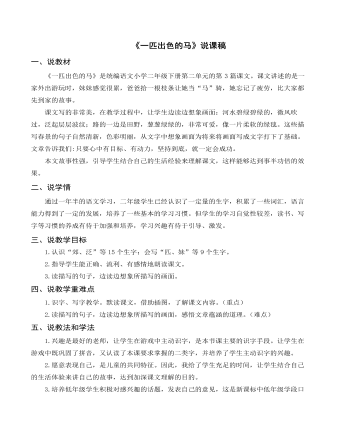
(说课稿)《一匹出色的马》部编人教版二年级上册语文
一、说教材《一匹出色的马》是统编语文小学二年级下册第二单元的第3篇课文。课文讲述的是一家外出游玩时,妹妹感觉很累,爸爸拾一根枝条让她当“马”骑,她忘记了疲劳,比大家都先到家的故事。 课文写的非常美,在教学过程中,让学生边读边想象画面:河水碧绿碧绿的,微风吹过,泛起层层波纹;路的一边是田野,葱葱绿绿的,非常可爱,像一片柔软的绿毯。这些描写春景的句子自然清新,色彩明丽,从文字中想象画面为将来将画面写成文字打下了基础。文章告诉我们:只要心中有目标、有动力,坚持到底,就一定会成功。 本文故事性强,引导学生结合自己的生活经验来理解课文,这样能够达到事半功倍的效果。二、说学情通过一年半的语文学习,二年级学生已经认识了一定量的生字,积累了一些词汇,语言能力得到了一定的发展,培养了一些基本的学习习惯。但学生的学习自觉性较差,读书、写字等习惯的养成有待于加强和培养,学习兴趣有待于引导、激发。三、说教学目标1.认识“郊、泛”等15个生字;会写“匹、妹”等9个生字。2.指导学生能正确、流利、有感情地朗读课文。3.读描写的句子,边读边想象所描写的画面。